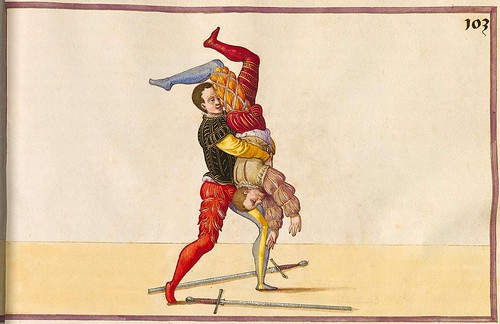
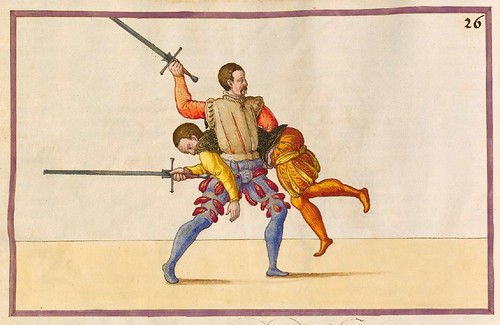

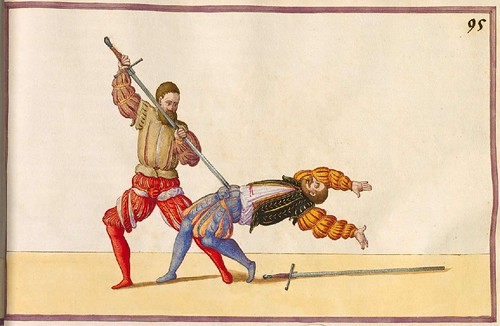


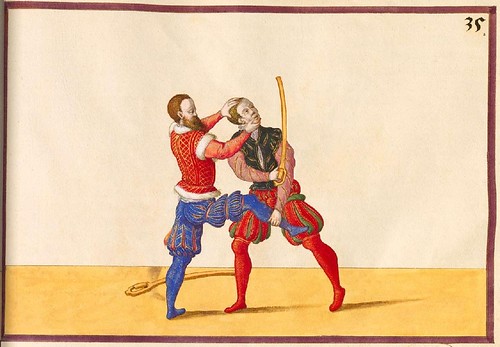
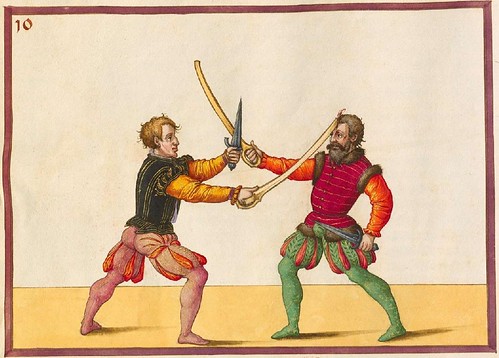
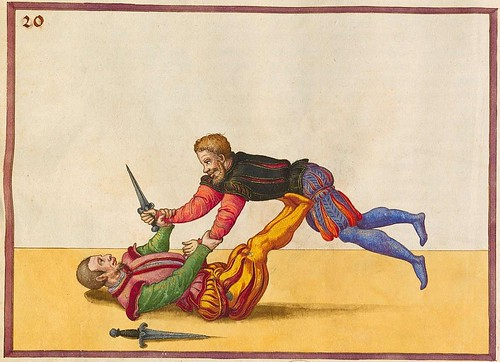

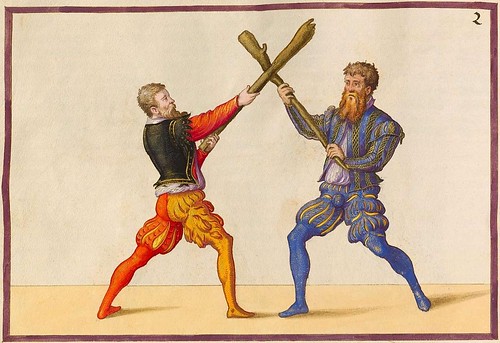
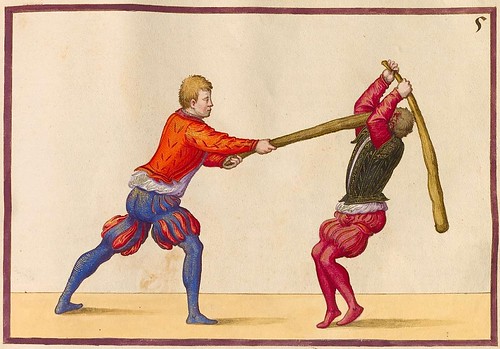
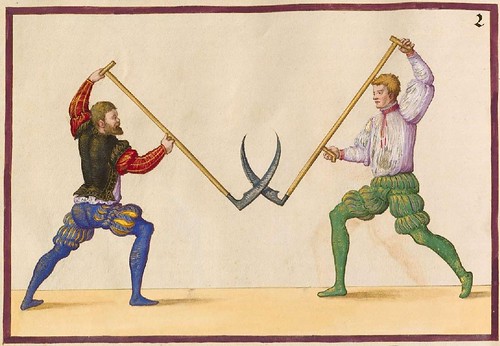

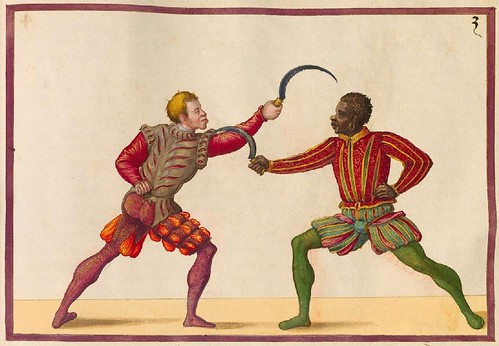




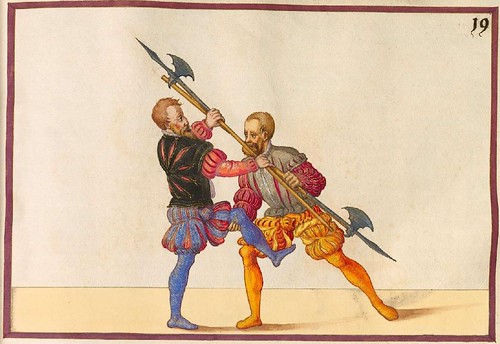
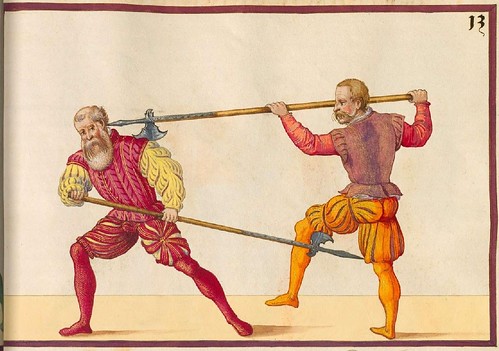

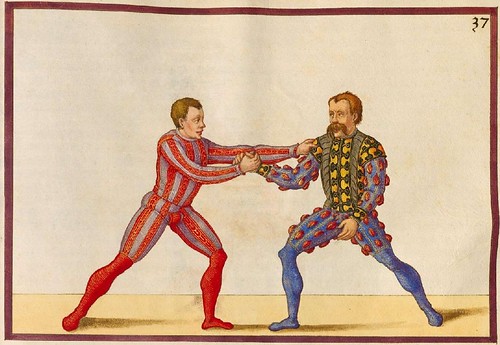
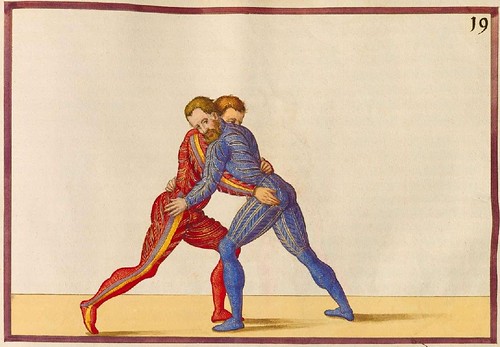
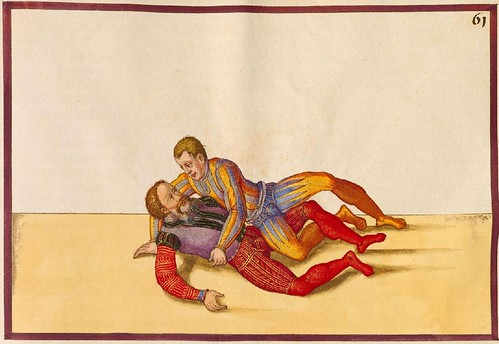
Volume I of 'De Arte Athletica' by Paul (Paulus) Hector Mair (mid-1500s) is online at the Bavarian State Library. It is more than 600 web pages long.
Weapons featured above include the halberd (a variation of pole-axe), long-sword, quarterstaff (maybe short-staff), sickle, dagger, dussack, scythe and a decidedly painful looking enlarged variation on a flail.
There are said to be only three copies of Mair's enormous manuscript, which belongs to the Fechtbücher tradition, left in the world. They are owned by the Bavarian Library (I'll probably sift through Vol. II in the future), Dresden Library* ('Opus Amplissimum de Arte Athletica') and the Austrian National Library ('Opus Amplissimum..' AKA: Codex Vindobensis). The Bavarian version is all in latin (the others are in German and latin) and the handwriting from the volume sampled above is exceptionally neat and legible throughout.
The Mair biography from the Academy of European Medieval Martial Arts (copied at a number of sites, including Wikipedia) [site includes microfilm scans of the Austrian manuscript):
"Paulus Hector Mair (1517–1579) was an Augsburg civil servant, and active in the martial arts of his time. He collected Fechtbücher and undertook to compile all knowledge of the art of fencing in a compendium surpassing all earlier books. For this, he engaged the painter Jörg Breu the Younger, as well as two experienced fencers, whom he charged with perfecting the techniques before they were painted. The project was very costly, taking full four years, and according to Mair, consumed most of his family's income and property. Three versions of his compilation, and one later, less extensive manuscript, have been preserved.
Not only did Mair spend huge sums on his collections and on his projects, he also had a very expensive lifestyle, frequently hosting receptions for the more important burghers of Augsburg. His own income was not sufficient for this, and during many years, he misappropriated funds from the city treasury, with the supervision of which he had been entrusted since 1541. His embezzlements were discovered in 1579, and Mair was hanged as a thief at the age of 62."
- If the Medieval and Renaissance fighting / pounding / stabbing and wrestling arts are your thing, then I strongly recommend looking through the previous posts under the combat tag which include a selection of material from many of the online 'fighting' manuals together with useful background links and information.
- The Association for Renaissance Martial Arts (ARMA) also have a photocopy quality version of what I suppose to be Codex Vindobensis.
- The Austrian Library E-wiki has a German transcription of 'De Arte Athletica'.
- Paulushectormair.com resolves to a blog called Ars Gladiatoris.
I think the site probably derives from or belongs to ARMA{addit: said to be no longer affiliated}. - "In 'Polearms of Paulus Hector Mair' [2008], authors Knight and Hunt make their contribution to the endeavor that Mair began so many centuries ago. Working from both the German and Latin versions of Mair's Opus, they present chapters on combat with the poleax, halberd, spear and shortstaff, and lance and longstaff, with text in the original German and Latin, along with the English translation. The illustrations, taken from the Dresden codices, C93 and C94, have been meticulously restored to give a clear view of the techniques."
- All the images above are approximately half-page details and were background cleaned to one extent or another. There are a few more in the set.



















28 comments :
Ah, yes, the scythe...so not one's weapon of choice. You get the distinct feeling that both the chaps in no. 5 are wishing they had an easy out, without losing face (or any other part of their anatomies). That'll teach them to pass offhand remarks about another guy's pants.
I absolutely love the title of this post!
Thanks for the giggle.
Other than the alarming stabbings, cudgelings, and attacks with scythes/flails, it all looks like practice fighting and vigorous exercise, done in the most decorative of costumes by persons with exceptionally well-developed calves. But given Mair's history, this is I think hardly surprising.
"Ah ha. Lets see if I've got this straight."
"If I admit that I'm in love with..."
[guard shakes his head."]
"No??"
[guard does a half somersault]
"Oh, If I say that I'm head over heels in love with Satan and all his little wizards, you will remove my testicles with a blunt instrument resembling some kind of gardening tool, but we can't quite make that out, and roast them over a large fire.
Whereas, if I don't admit that I'm head over heels in love with Satan and all his little wizards, you will hold me upside down in a vat of warm marmalade..
[pause..sees guard isn't finished...realisation]
AND remove my testicles with a blunt instrument resembling some kind of gardening tool.
Well in that case, I love Satan....
[guard produces a scythe]
Oh, it's a scythe....."
You know your blog has /really/ arrived when some of the comments are as compelling reading as the blog itself!
Must be the season of the pants. The Errant Aesthete recently posted a few rough and tumble medieval madmen with a penchant for sartorial posturing. Of course, your amusingly titled 'Pugnacious Puffy Pants' is far superior to 'Pants Optional' [http://theerrantaesthete.com/2009/01/30/pants-optional/]but there is a distinct departure in styles. Nicely done!
dross1260 has definitely outdone me this time. And I concur with Kittybriton.
I think the tradition of wearing hot pink, bright orange or lime green puffy pants arose in tandem with the ability to wield a big club or a pointy metal object.
Brilliant as usual. by the way, some weeks ago you comment my post about the 1525 Straßburg Ptolemy edition - know the hole work ist online. you will find it here: http://digital.slub-dresden.de/sammlungen/werkansicht/274197766/0/ (the place of publication on the webside is wrong)Its a beautyful edition with colored maps. Hope you will enjoy it. Ortelius
Thanks Ortelius. I've seen the 1467 Ptolemy manuscript - 'Cosmographia' - from the Polish Digital Library previously.
Excellent!!! Me encantan este tipo de ilustraciones, los pantalones son fantásticos. Thanks
Ah, sweet combat illustrations from yore - my favorite! Thanks again for the amazing blog!
Is it just me or are pics 26 onwards a bit homoerotic?
If you're really looking to humiliate your opponent, there's nothing quite like #7 with the flail.
I have to say that this one of the most fantastic blogs. Where to post a comment ? all over this blog....Glad i found it.
My first thought: what lovely outfits!
My second thought: ouch!
–Lana
Regarding the pants and general attire, perhaps I can offer some insight. It's like Renaissance "bling." The custom of wearing mismatched, ostentatious clothing of this sort began with the German Landsknechts, basicly the elite professional infantry of the time. Landsknechts (or "servants of the land") were instituted by Emperor Maximilian I, and they had a habit of canibalizing the fine clothing of their fallen opponents; slashing their clothing and sewing the materials pirated from those they killed in between to create that "puffy" look you talk about. The more exotic \ peacockesque your clothing, the more of a badass you were, because that meant you'd killed a lot of people. It wasn't long before makers of clothing started creating such garments on purpose, and it became a fashion statement. It's a different kind of masculinity than we understand today by and large, and certainly not "homoerotic," (though it may certainly seem that way if you're of that persuasion). Again, it's like "bling." First the ganger rappers wear it, aping high fashion, and then everyone copies them. Nothing's new.
-Brandon Heslop
lessonsontheenglishlongsword.blogspot.com
Thanks Brandon. It's hard not to regard these illustrations -- irrespective of the manliness/status particulars of the age -- as a campy farce from our perspective. I think we can have some regard for the historical elements yet still have a chuckle at the illustrations.
So, if the lower status fighters were less encumbered by the bling of the times, wouldn't that have been an advantage in battle? They'd have freer movement wouldn't they?
Well, if one takes a look at the "cut" of the clothing, it's very form-fitting. This gives you very good freedom of movement.
As for having a chuckle, why not?
:)
-B.
I'd also think the clothing takes something of a cue from earlier fashions, which had puffy bits here and there (not on the pants that I can recall, admittedly), and especially the way people used to have slashes in the sleeves and so on to show off the contrasting fabric underneath.
On a different topic, it's about time someone clarified what "bling" is. Going on the word's use in advertising since my return from Prague, I wasn't sure whether it meant money, jewelry, or what. Oh well. Sounds like it's merely what I see on the bus every day.
I suppose I've always taken bling to mean ostentatious metal jewellery and particularly neck chains and particularly gold (maybe) and more associated with men (another maybe). I think it has extended to include other ostentatious accoutrements such as tricked out cars.
So with such a fluid definition, and as we are in the confines of a narrow conversation such as a comment thread, I can easily take it - tacit agreement - to extend to ostentatious pieces of clothing +/- metal as I believe was intimated by Brandon.
I think all definitions have to include that word 'ostentatious'. Bling is above and beyond necessity and is always for show. It's what the Joneses eat for breakfast.
Not having my mind as firmly centered on present-day popular culture as it could be, I am always prepared to be brought up to date. I had kind of grasped the ostentatious aspect of bling, but now I could probably even use the word correctly in conversation.
There's a LOT of bling riding on my bus. Imagery of dollar signs and diamonds is rife.
Very, very entertaining analysis.
Also keep in mind that Mair's works were written for the nobility, who undoubtedly appreciated the bling and had highly fashionable bling of their own.
For the record, Ars Gladiatoris is no longer affiliated with ARMA in any way, shape or form.
So noted, thanks Skiritai.
Although it's probably self evident, I spent quite a bit of time working out the order of the images posted above so Lady Meerkat's homoerotic comment was inevitable: it was intended to be something of a set up towards that (ironic) conclusion.
But then, I also expected someone to note that the term clubbing has changed over the centuries... *cough*
I so wish the curator I met with this afternoon, who admittedly had some interesting things to say about why she hung the photos in the manner she did, would have confessed to arranging the works to lead to a particularly entertaining (it would not in this case have been very homoerotic) effect.
It could have been done, but I don't think that was quite her intent.
Nice post
Nice post
couldn't resist toput them into motion: :)
http://r-i-p-alice.tumblr.com/image/132815225997
Post a Comment
Comments are all moderated so don't waste your time spamming: they will never show up.
If you include ANY links that aren't pertinent to the blog post or discussion they will be deleted and a rash will break out in your underwear.
Also: please play the ball and not the person.
Note: only a member of this blog may post a comment.